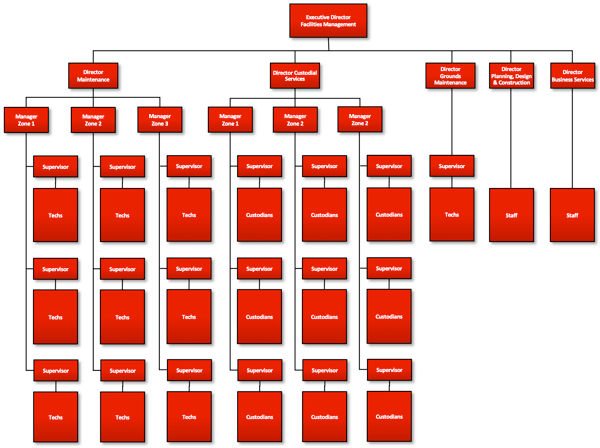March 2022
Facilities Management – My Way
 What are the essentials for a good facilities management organization? Opinions about entire companies, institutions, or governments are not offered – beyond my expertise. What are the essentials for a good facilities management organization? Opinions about entire companies, institutions, or governments are not offered – beyond my expertise.
What’s Best? Seven Types to Consider
Some references cite these organizational structure types:
- Hierarchical Structure
- Divisional Structure
- Line Organizational Structure
- Horizontal/Flat Structure
- Matrix Structure
- Network Structure
- Team-based Organizational Structure
At a practical level. within facilities management organizations, I see little difference between the first three. I call them “tree” diagrams because they all have “roots” that feed up to one “trunk”. The final three are essentially non-existent in these organizations, although some defined responsibilities of “tree” diagrams (such as business services) may have “matrix” characteristics.
Yes, there are others. But, I can’t get too distracted.
My basics:
Beware The “Horizontal/Flat” Approach
 The Horizontal/Flat Structure deserves a special warning. The Horizontal/Flat Structure deserves a special warning.
In many situations, where very specific groups are developed to address specific issues, they may survive as stand-alone entities. This is readily apparent when a manager, director, or other leader has a large list of direct reporting personnel. This has two major defects:
- Management Challenges
- It defies common recommendations for “span of control” – how many people can one manager handle at once. There are plausible rules of thumb on this topic, and a wide, flat organization defies them.
- Customer Service
- It’s a nightmare for customers. Simply finding the group they want to talk to isn’t easy.
- Equally important is that when they want to “talk to the supervisor”, they have no choice but to go to the manager who may already be overloaded with other day-to-day obligations.
Make It “Approachable”
 For small organizations (say 20 people or less), this is no real challenge. However, as organizations grow from dozens to hundreds of people, they are intimidating to most outsiders. Consequently, how the facilities management organization accommodates outsider interface is key. One central “customer service” entity has value. One number to call. One place to register complaints, requests for service, or any need for help. For small organizations (say 20 people or less), this is no real challenge. However, as organizations grow from dozens to hundreds of people, they are intimidating to most outsiders. Consequently, how the facilities management organization accommodates outsider interface is key. One central “customer service” entity has value. One number to call. One place to register complaints, requests for service, or any need for help.
In very large organizations, there’s a need to publicly explain the structure to the larger service community with comprehensible clarity. That clarity can be seen in the organization (org) chart. Staffing and management of related activities show as discernable clusters of the larger organization.
Have Parity Between “Capital” And “Operations”
As facilities management organizations grow in size, the people responsible for managing design and construction of alterations, renovations and new construction often get separated from those responsible from facilities maintenance. A tell-tale sign of this defect is an org chart that shows these groups and their leaders squirreled away into silos that have little apparent linkage. The necessary collaboration is not part of the structure.
To some extent this can be offset by good intentions and performance of the parties. But a good org chart will have these people literally, or at least figuratively, side by side.
Break Operations Into “Zones”
As indicated, connections to the campus community are important. Equally important is having a work force that develops an entrenched familiarity with the spaces they maintain. Two types of “zones” are common:
- Zones based on geography, e.g., East/West.
- Zones based on building type, e.g., Academic/Residential or Office/Manufacturing.
From a customer viewpoint, I would be informed who my Zone Manager is, so I won’t have to go searching around an obscure organization to discuss concerns or objectives.
Have Parallel Maintenance And Custodial Operations
 With zone designations, there should be no difference between those for maintenance and those for custodial service. Customers don’t need to be confused by differences, and facilities maintenance staff members are better off with the simplicity of a unified approach. With zone designations, there should be no difference between those for maintenance and those for custodial service. Customers don’t need to be confused by differences, and facilities maintenance staff members are better off with the simplicity of a unified approach.
Encourage “Cross-Talk”
 With parallel maintenance and custodial departments, especially when zones are adopted, peer to peer connections should become apparent. Supervisors, Managers, and Directors of the two disciplines land at the same tier. But more importantly, there is the enabling of an institutional culture when needs and conflicts can be addressed person-to-person at the crew, zone, or department level. Good leadership strives for this. With parallel maintenance and custodial departments, especially when zones are adopted, peer to peer connections should become apparent. Supervisors, Managers, and Directors of the two disciplines land at the same tier. But more importantly, there is the enabling of an institutional culture when needs and conflicts can be addressed person-to-person at the crew, zone, or department level. Good leadership strives for this.
Have A Discernable Career Path
For those with ambitions, an obvious, climbable ladder should be apparent. Technician to Supervisor to Manager to Director to Executive Director is good.
Each step has a well written, understandable job description with position requirements and responsibilities. Additionally, for good measure, it should be understood where on the ladder there the inevitable transition to “management” is, e.g., hourly to salary, non-exempt to exempt, or bargaining unit to non-bargaining unit.
What might this look like?
Here’s a simplified example for an organization of perhaps 100 people.

If you want a download of this diagram, click here.
Your Mileage May Vary
Every facilities maintenance organization, it seems, is unique. History, tradition, nomenclature, specialization, and entrenchment are site-specific. And size matters.
Nevertheless, I still strive for my “basics”. How they may get tweaked is nuanced. If lucky, they will remain intact. One hopes…
Missed earlier newsletters? Find them here:
January 2022 “Report Writing for Dummies"
October 2021 “Writer's Block and Other Musings"
May 2021 “Lower Ed?”
September 2020 “Just Stylin'”
July 2020 “Reflections on Our Covid Times”
February 2020 “Quirky Clients – The Smart Version”
September 2019 “OPM Cheerleader”
June 2019 “Can You Perform?”
February 2019 “Today's Word”
October 2018 “The Case for DIversity-Architect's Version”
June 2018 “A Capital Idea”
March 2018 “Me Too?”
January 2018 “R U Trending?”
October 2017 “Do You Measure Up?”
August 2017 “I'm an Architect and I'm Here to Help”
January 2017 “The Future of Higher Education”
November 2016 “The Owner as CM?”
August 2016 “Don't you just hate...”
June 2016 “Duck Testing”
April 2016 “Once Upon a Time...”
January 2016 “I want to take you higher”
November 2015 “Moderating in all Things?”
July 2015 “Alphabet City”
May 2015 “Acey Trey Trey Trey?”
January 2015 “Nature or Nurture?”
August 2014 “Acey Trey Trey?”
June 2014 “The Seven Deadly Sins”
March 2014 “Thar She Blows!”
November 2013 “Giving Thanks”
September 2013 “Back to School?”
June 2013 “What Time is It?”
March 2013 “Acey Deucey?”
January 2013 “A Swamp Full of Alligators”
October 2012 “Plan to Live Forever, Part Deux”
July 2012 “A Midsummer Dream”
May 2012 “Are you Virtually Working?”
March 2012 “Your Huddled Masses”
January 2012 “Observing Observations”
October 2011 “I Want What I Want”
August 2011 “A Beach Read”
May 2011 “NeoLuddite or Technophile?”
March 2011 “Do Your Silos Leak?”
January 2011 “Plan to Live Forever!”
November 2010 “May I Have A Plan, Master?”
September 2010 “How do we choose?”
July 2010 “Good People Behaving Badly”
May 2010 “LEED: LEADing or Dead Weight?”
March 2010 “Why does it cost so much?”
January 2010 “Design/Builders show us your softer side.”
November 2009 “What the Facilities?”
September 2009 “Why Do Architects Make Good Owner’s Reps?” |

 What are the essentials for a good facilities management organization? Opinions about entire companies, institutions, or governments are not offered – beyond my expertise.
What are the essentials for a good facilities management organization? Opinions about entire companies, institutions, or governments are not offered – beyond my expertise.
 The Horizontal/Flat Structure deserves a special warning.
The Horizontal/Flat Structure deserves a special warning. For small organizations (say 20 people or less), this is no real challenge. However, as organizations grow from dozens to hundreds of people, they are intimidating to most outsiders. Consequently, how the facilities management organization accommodates outsider interface is key. One central “customer service” entity has value. One number to call. One place to register complaints, requests for service, or any need for help.
For small organizations (say 20 people or less), this is no real challenge. However, as organizations grow from dozens to hundreds of people, they are intimidating to most outsiders. Consequently, how the facilities management organization accommodates outsider interface is key. One central “customer service” entity has value. One number to call. One place to register complaints, requests for service, or any need for help. With zone designations, there should be no difference between those for maintenance and those for custodial service. Customers don’t need to be confused by differences, and facilities maintenance staff members are better off with the simplicity of a unified approach.
With zone designations, there should be no difference between those for maintenance and those for custodial service. Customers don’t need to be confused by differences, and facilities maintenance staff members are better off with the simplicity of a unified approach. With parallel maintenance and custodial departments, especially when zones are adopted, peer to peer connections should become apparent. Supervisors, Managers, and Directors of the two disciplines land at the same tier. But more importantly, there is the enabling of an institutional culture when needs and conflicts can be addressed person-to-person at the crew, zone, or department level. Good leadership strives for this.
With parallel maintenance and custodial departments, especially when zones are adopted, peer to peer connections should become apparent. Supervisors, Managers, and Directors of the two disciplines land at the same tier. But more importantly, there is the enabling of an institutional culture when needs and conflicts can be addressed person-to-person at the crew, zone, or department level. Good leadership strives for this.